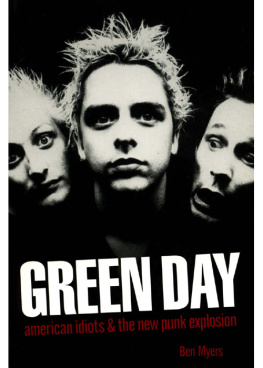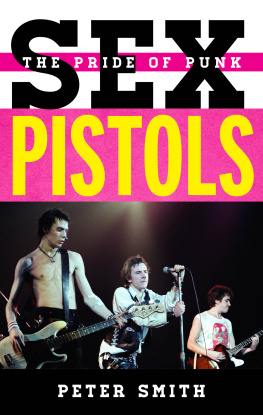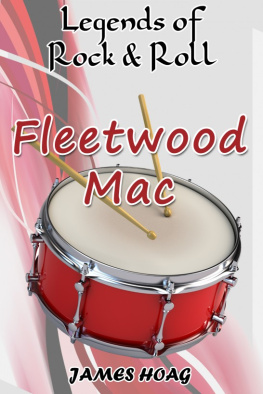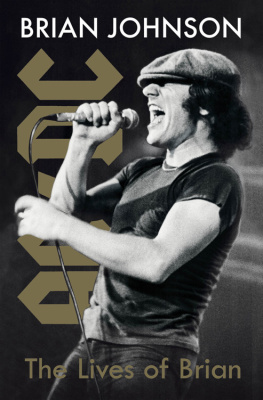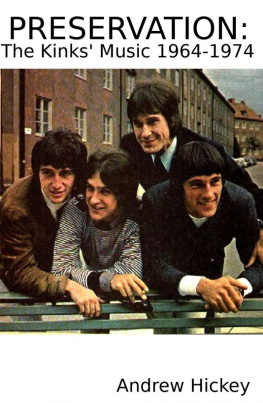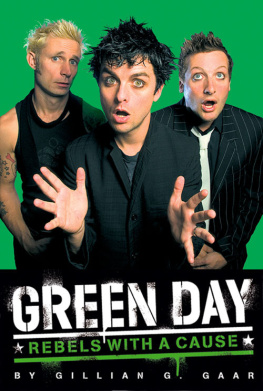
Copyright 2006 I.M.P. Publishing Ltd.
Published by The Disinformation Company Ltd.
163 Third Avenue, Suite 108
New York, NY 10003
Tel.: +1.212.691.1605
Fax: +1.212.691.1606
www.disinfo.com
An earlier edition of this book was published in the UK by Independent Music Press, part of I.M.P. Publishing Ltd. This edition has been updated and revised for publication in North America.
All rights reserved. No part of this book may be reproduced, stored in a database or other retrieval system, or transmitted in any form, by any means now existing or later discovered, including without limitation mechanical, electronic, photographic or otherwise, without the express prior written permission of the publisher.
Library of Congress Control Number: 2006920459
ISBN-10: 1-932857-32-X
ISBN-13: 978-1932857-32-0
Printed in USA
Design and Layout: Maya Shmuter
10 9 8 7 6 5 4 3 2 1
Distributed in the USA and Canada by:
Consortium Book Sales and Distribution
1045 Westgate Drive, Suite 90
St Paul, MN 55114
Toll Free: +1.800.283.3572 Local: +1.651.221.9035
Fax: +1.651.221.0124
www.cbsd.com
Cover Design by Fresh Lemon.
Edited by Martin Roach (UK) and Jason Louv (US).
www.redwheelweiser.com
www.redwheelweiser.com/newsletter
CONTENTS
ACKNOWLEDGEMENTS
Thank you to everyone involved in the research and writing of this book, and to all those interviewed. The author would also like to extend special gratitude to Emma Van Duyts and Phoebe Sinclair at Warner Bros. UK for being extremely accommodating (and buying lunch), Andrea Graham for knowing more about Green Day than anyone else, Ian Winwood for kindly donating valuable interview transcripts and providing insight, Lisa Johnson in LA for the many suggestions and all-round encouragement, the Myers family, Davey James, Kara Cooper, Anthony Luke, John Robb, Caroline Fish, the staff and Melody Maker 1996-1999 and Kerrang! for the opportunities, Martin, Kaye and Alfie Roach, and Richard, Lee and the illustrious Captains of Industry bands (www.captainsof.com). Although this is an unofficial and unauthorized book, I would also like to express my thanks to Green Day and their management, who have always proven to be very accommodating people when I have interviewed them for magazines, and whose music has taken me to places I never thought I'd see. I hope this book does their story justice.
Extracts from some of the author's own interviews have previously appeared in other forms in Melody Maker, Kerrang! and a number of fanzines and websites. These encounters took place over a number of years in Milan, London, Los Angeles and Nottingham.
This book is dedicated to Mark Robinson, forever teenage.
Ben Myers
AUTHOR'S NOTE
Wherever necessary I have occasionally adopted a first person narrative approach where my own eyewitness accounts are concerned, or else have injected some of my own recollections into this book While I recognize this might, on occasion, read like a literary indulgence, I hope that readers might appreciate the reality of encountering bands as opposed to the toned-down, edited highlights that might appear in magazines or TV. The truth is in the peripheral detail the unspoken glances, the tone of voice. This, then, is an interpretation.
Also, because Green Day and their music have featured in my life in one capacity or another for the past fifteen years on the radio, on stage, in the flesh as they have with millions of others, it's almost impossible to remain impartial (and dull).
To that end I have included the odd personal anecdote to provide a wider context and illustrate the effect that the band have had on those anonymous fans like me around the world.
Besides, all music and writing is personal it is how the individual reacts to it that matters. This is my take on it. It's neither better nor worse than yours. Just different.

Go west, young man, go west!
Advice given by Indiana newspaper writer John B. L. Soule in 1851, later adopted as a mantra for Nineteenth Century American migration.
Oakland, California, has a rich and colorful history, and that color is predominantly gold. The land that surrounds San Francisco's Bay Area was first settled upon some 1,200 years BC and inhabited by transient tribes for centuries upon centuries before Spanish explorers became the first Europeans to visit the East Bay in 1772. Within thirty years the Mission de San Jose had been established in the settlement of Fremont and imposed Spanish jurisdiction over the area that would one day be called Oakland. A man named Don Luis Maria Peralta was awarded a 44,800-acre land grant from the King of Spain that spanned most of present-day Alameda county; the first non-Native American dwelling was built in 1821. And that was that for a number of decades. The Spanish had staked their claim for this corner of California and their legacy still looms strong today, not least in street names and surrounding towns. The white man had arrived to irrevocably change the area forever.
Quite how much the landscape, economy, psyche and psychogeography of Oakland would be changed over the coming decades or indeed the coming two centuries could never have been predicted but, in 1848, change it did.
When James Marshall, described as a dour, paranoid carpenter from New Jersey, discovered a pea-shaped lump of gold in a sawmill ditch in Coloma (near Sacramento) in January 1848, the course of American history was changed forever. Boys, Marshall told the group of laborers who were helping him build the sawmill, By God, I believe I have found a gold mine.
Times were hard, and nothing captures the imagination of the poor quite like the accidental discovery of gold. What followed was one of the biggest mass migrations on record, as 90,000 people flocked to California from all over the country and from places as far-flung as Chile and Mexico in the two years following Marshall's discovery; the average journey took five months. California, as we now know it, was born.
By 1854 the total of migrants numbered over 300,000 optimistic prospectors one in nine of every American citizen. The census of 1850 found that seventy-three percent of California's population was between the ages of twenty and forty, and ninety-two percent were males. These people came not to settle, but to take. The mortality rate was high, as many young men died from accidents, disease or conflict with their neighbors. Among the first places they flocked to was one of the largest towns, San Francisco, and the surrounding Bay Area. The influx spread sideways and new settlements appeared across Oakland. In the stampede, California became a state of strangers, of prospectors or, more likely, failed prospectors ensuring that it was a place quite unlike anywhere else in America.
But before the Gold Rush, Californians were occupying themselves with other pursuits, one of the most popular being rodeo, a pastime that combined practical elements of the frontiersman's life with a showy machismo-based form of entertainment, and which spawned a town of the same name, Rodeo (pronounced Row-day-oh) in Contra Costa county, a suburban county in San Francisco's Bay Area. The rodeo was like a primitive precursor to rock 'n' roll, a chance for young men to show off their physical and sexual prowess in the most obvious and no-brainer way possible by wrestling livestock in the dusty Californian dirt in front of excitable crowds of ranchers, farm-hands, livestock owners, rustlers, hustlers, thieves and their families. It was and in many areas of the country remains a great American tradition. America loves its meat, and the rodeo was just one more by product of an alternative economy to gold, that of beef. Welcome to cowboy country.
Next page
